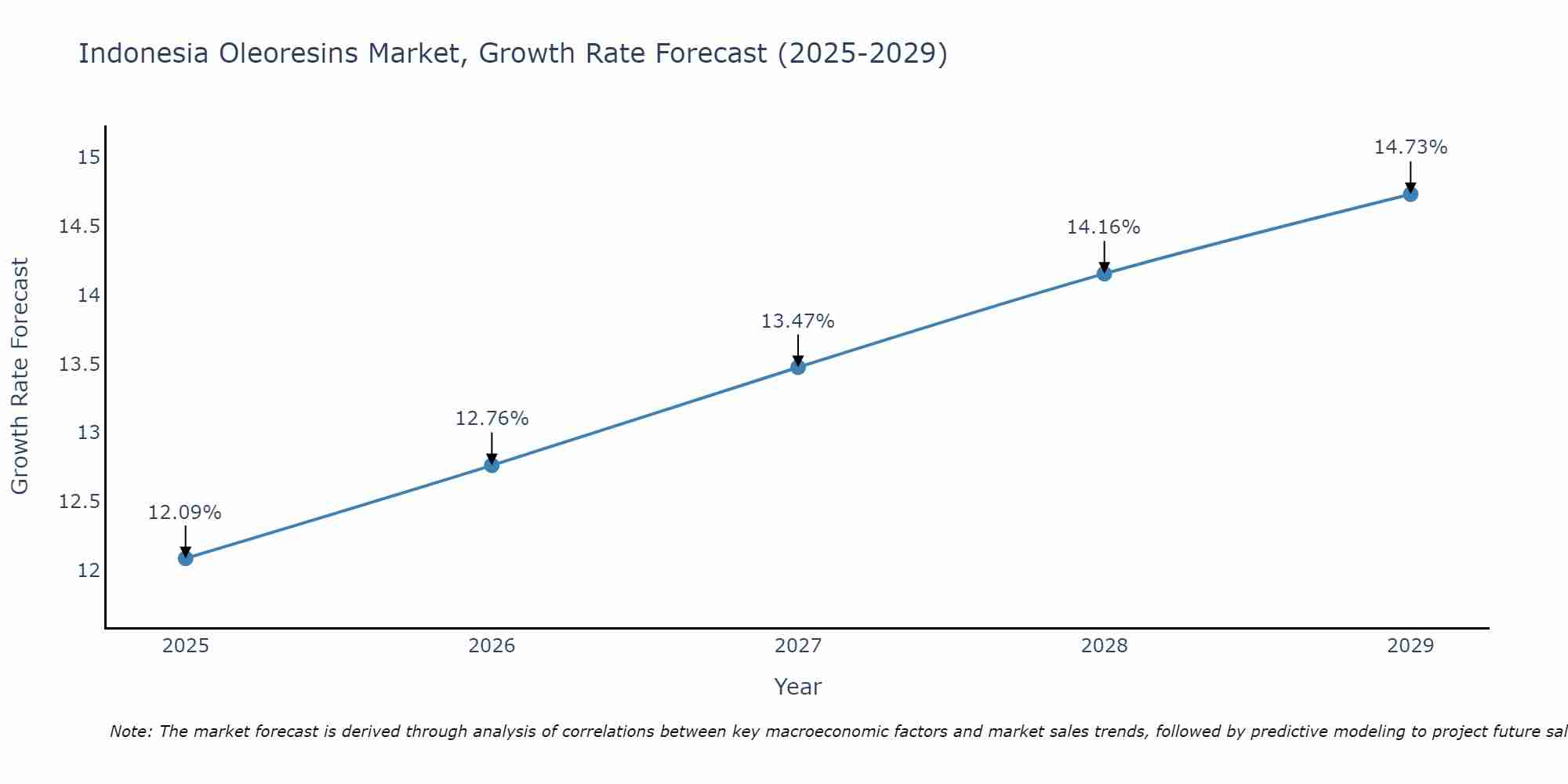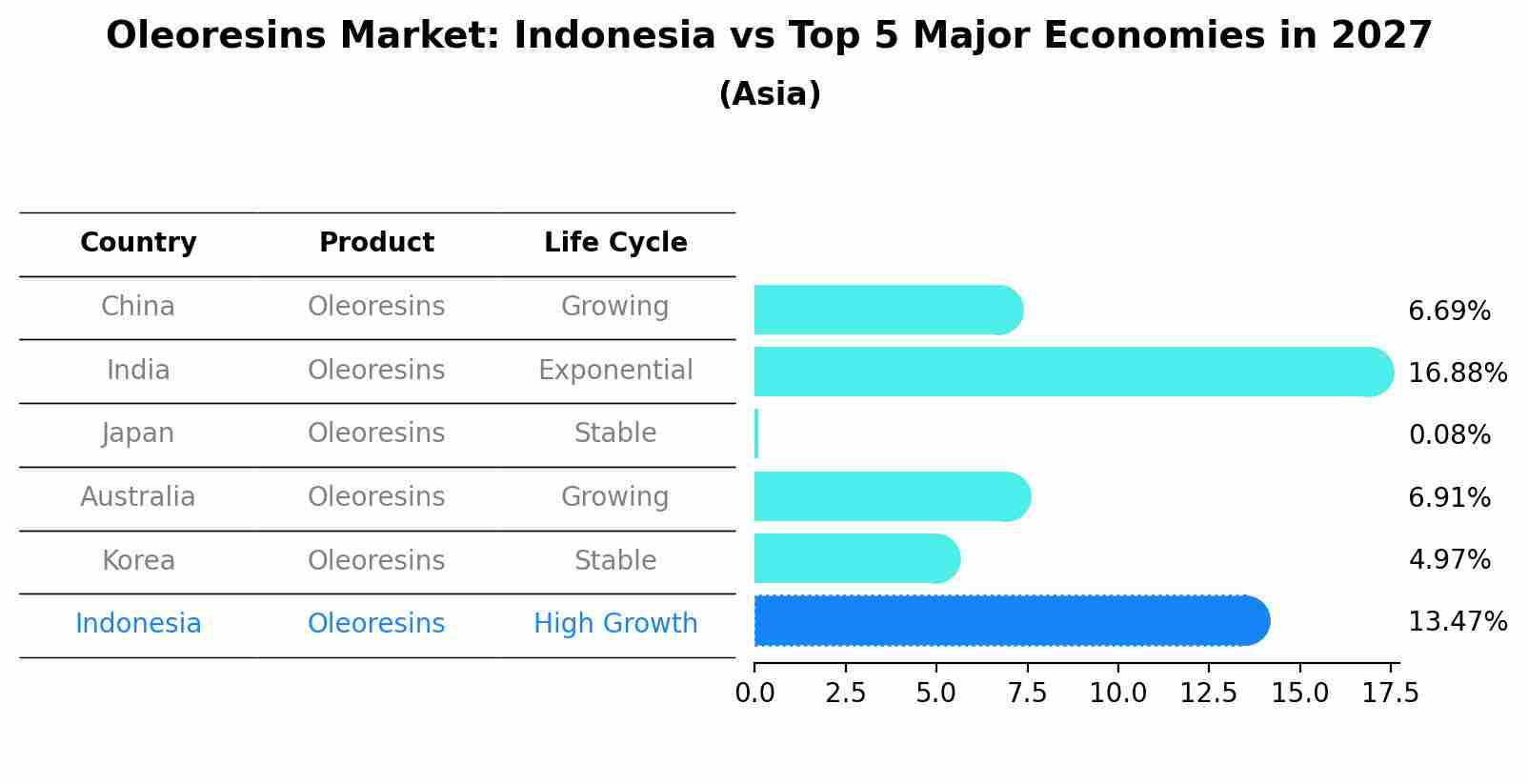Indonesia Oleoresins Market (2025-2031) Outlook | Share, Companies, Analysis, Forecast, Industry, Growth, Value, Trends, Revenue, Size
| Product Code: ETC097067 | Publication Date: Jul 2023 | Updated Date: Aug 2025 | Product Type: Report | |
| Publisher: 6Wresearch | No. of Pages: 70 | No. of Figures: 35 | No. of Tables: 5 | |
Indonesia Oleoresins Market Size Growth Rate
The Indonesia Oleoresins Market is poised for steady growth rate improvements from 2025 to 2029. Commencing at 12.09% in 2025, growth builds up to 14.73% by 2029.

Oleoresins Market: Indonesia vs Top 5 Major Economies in 2027 (Asia)
The Oleoresins market in Indonesia is projected to grow at a high growth rate of 13.47% by 2027, highlighting the country's increasing focus on advanced technologies within the Asia region, where China holds the dominant position, followed closely by India, Japan, Australia and South Korea, shaping overall regional demand.

Indonesia Oleoresins Market Synopsis
Indonesia is one of the largest exporters of oleoresins in Southeast Asia. It is a major source for essential oils, fragrances and flavors used in food, beverages, health care products and pharmaceuticals. Oleoresins are extracted from various plants such as black pepper, nutmeg, clove bud and cardamom by using solvent extraction process. The increasing demand for spicy foods has been driving the growth of oleoresins market in Indonesia over the years. Furthermore, rising awareness about health benefits associated with natural ingredients has led to an increased demand for organic or minimally processed food products which contain these oleoresins.
Market Trends
The trends observed in Indonesia Oleresin Market include development and adoption of advanced technologies for processing these extracts to meet international standards; increasing collaborations between farmers? associations and private companies to facilitate production; rise in investment towards research & development activities related to medicinal properties; growing preference among consumers for convenience-oriented packaged products containing natural flavorings derived from oleoressin extracts; increase usage of cost effective biotechnological processes instead of traditional methods; introduction of organic certification programs aiming at marketing quality extracts produced through sustainable farming practices etc.
Market Drivers
Some key factors driving growth within this sector include increasing consumption rate across multiple industries including food & beverage (F&B), cosmetics & personal care (CPC), pharmaceuticals etc.; expanding global economy creating opportunities across several countries along with new markets reaching out for exportable items like spices ; initiatives taken by the government authorities towards quality control measures concerning exports ensuring safety standards are met ; introduction of improved production techniques leading to higher output levels catering larger section of population coupled with availability high grade raw materials required during extractions processes at low costs. Growing presence eco-friendly packaging solutions enhancing consumer experience also serves as another driver behind this industry`s expansion.
COVID-19 Impact on the Market
The Indonesia oleoresin market was impacted significantly by the COVID-19 pandemic due to declining economic activity and a decrease in demand for natural ingredients, resulting in lower sales volumes for oleoresins. Moreover, the disruption of supply chains has hindered the production process of oleoresins, further limiting its growth potential.
Challenges of the Market
Challenges faced by the Indonesia oleoresin market include rising raw material prices and difficulty in obtaining high-quality natural ingredients. Additionally, manufacturers have also been facing issues with product quality control due to lack of experienced personnel during this crisis period. To mitigate these issues, companies are focusing on maintaining cost efficiency by making use of automated manufacturing processes and streamlining their operations.
Industry Key Players
Some key players operating in the Indonesia Oleoresins Market include JAVA Aromatics & Essential Oils Inc., Firmenich Indonesia PT., SABAR INDONESIA CV., Sonarome Natural Extracts Pvt Ltd., Symrise AG India Private Limited, Omega Ingredients Ltd (UK), and Natures Aid UK Ltd among others.
Key Highlights of the Report:
- Indonesia Oleoresins Market Outlook
- Market Size of Indonesia Oleoresins Market, 2024
- Forecast of Indonesia Oleoresins Market, 2031
- Historical Data and Forecast of Indonesia Oleoresins Revenues & Volume for the Period 2021-2031
- Indonesia Oleoresins Market Trend Evolution
- Indonesia Oleoresins Market Drivers and Challenges
- Indonesia Oleoresins Price Trends
- Indonesia Oleoresins Porter's Five Forces
- Indonesia Oleoresins Industry Life Cycle
- Historical Data and Forecast of Indonesia Oleoresins Market Revenues & Volume By Extraction process for the Period 2021-2031
- Historical Data and Forecast of Indonesia Oleoresins Market Revenues & Volume By Solvent extraction for the Period 2021-2031
- Historical Data and Forecast of Indonesia Oleoresins Market Revenues & Volume By Supercritical fluid extraction for the Period 2021-2031
- Historical Data and Forecast of Indonesia Oleoresins Market Revenues & Volume By Application for the Period 2021-2031
- Historical Data and Forecast of Indonesia Oleoresins Market Revenues & Volume By Food & beverages for the Period 2021-2031
- Historical Data and Forecast of Indonesia Oleoresins Market Revenues & Volume By Pharmaceuticals & nutraceuticals for the Period 2021-2031
- Historical Data and Forecast of Indonesia Oleoresins Market Revenues & Volume By Personal care products for the Period 2021-2031
- Historical Data and Forecast of Indonesia Oleoresins Market Revenues & Volume By Feed for the Period 2021-2031
- Historical Data and Forecast of Indonesia Oleoresins Market Revenues & Volume By Sources for the Period 2021-2031
- Historical Data and Forecast of Indonesia Oleoresins Market Revenues & Volume By Paprika for the Period 2021-2031
- Historical Data and Forecast of Indonesia Oleoresins Market Revenues & Volume By Capsicum for the Period 2021-2031
- Historical Data and Forecast of Indonesia Oleoresins Market Revenues & Volume By Seed spices for the Period 2021-2031
- Historical Data and Forecast of Indonesia Oleoresins Market Revenues & Volume By Turmeric for the Period 2021-2031
- Historical Data and Forecast of Indonesia Oleoresins Market Revenues & Volume By Ginger for the Period 2021-2031
- Historical Data and Forecast of Indonesia Oleoresins Market Revenues & Volume By Cinnamon & cassia for the Period 2021-2031
- Historical Data and Forecast of Indonesia Oleoresins Market Revenues & Volume By Herbs for the Period 2021-2031
- Historical Data and Forecast of Indonesia Oleoresins Market Revenues & Volume By Others for the Period 2021-2031
- Indonesia Oleoresins Import Export Trade Statistics
- Market Opportunity Assessment By Extraction process
- Market Opportunity Assessment By Application
- Market Opportunity Assessment By Sources
- Indonesia Oleoresins Top Companies Market Share
- Indonesia Oleoresins Competitive Benchmarking By Technical and Operational Parameters
- Indonesia Oleoresins Company Profiles
- Indonesia Oleoresins Key Strategic Recommendations
Frequently Asked Questions About the Market Study (FAQs):
1 Executive Summary |
2 Introduction |
2.1 Key Highlights of the Report |
2.2 Report Description |
2.3 Market Scope & Segmentation |
2.4 Research Methodology |
2.5 Assumptions |
3 Indonesia Oleoresins Market Overview |
3.1 Indonesia Country Macro Economic Indicators |
3.2 Indonesia Oleoresins Market Revenues & Volume, 2021 & 2031F |
3.3 Indonesia Oleoresins Market - Industry Life Cycle |
3.4 Indonesia Oleoresins Market - Porter's Five Forces |
3.5 Indonesia Oleoresins Market Revenues & Volume Share, By Extraction process, 2021 & 2031F |
3.6 Indonesia Oleoresins Market Revenues & Volume Share, By Application, 2021 & 2031F |
3.7 Indonesia Oleoresins Market Revenues & Volume Share, By Sources, 2021 & 2031F |
4 Indonesia Oleoresins Market Dynamics |
4.1 Impact Analysis |
4.2 Market Drivers |
4.2.1 Growing demand for natural food additives and flavors in the food and beverage industry |
4.2.2 Increasing awareness about the health benefits of using oleoresins in various applications |
4.2.3 Rise in disposable income leading to higher consumption of processed foods and beverages |
4.3 Market Restraints |
4.3.1 Fluctuating prices of raw materials used in oleoresins extraction |
4.3.2 Stringent regulations and quality standards for the production and export of oleoresins |
4.3.3 Limited availability of skilled labor for the extraction and processing of oleoresins |
5 Indonesia Oleoresins Market Trends |
6 Indonesia Oleoresins Market, By Types |
6.1 Indonesia Oleoresins Market, By Extraction process |
6.1.1 Overview and Analysis |
6.1.2 Indonesia Oleoresins Market Revenues & Volume, By Extraction process, 2021-2031F |
6.1.3 Indonesia Oleoresins Market Revenues & Volume, By Solvent extraction, 2021-2031F |
6.1.4 Indonesia Oleoresins Market Revenues & Volume, By Supercritical fluid extraction, 2021-2031F |
6.2 Indonesia Oleoresins Market, By Application |
6.2.1 Overview and Analysis |
6.2.2 Indonesia Oleoresins Market Revenues & Volume, By Food & beverages, 2021-2031F |
6.2.3 Indonesia Oleoresins Market Revenues & Volume, By Pharmaceuticals & nutraceuticals, 2021-2031F |
6.2.4 Indonesia Oleoresins Market Revenues & Volume, By Personal care products, 2021-2031F |
6.2.5 Indonesia Oleoresins Market Revenues & Volume, By Feed, 2021-2031F |
6.3 Indonesia Oleoresins Market, By Sources |
6.3.1 Overview and Analysis |
6.3.2 Indonesia Oleoresins Market Revenues & Volume, By Paprika, 2021-2031F |
6.3.3 Indonesia Oleoresins Market Revenues & Volume, By Capsicum, 2021-2031F |
6.3.4 Indonesia Oleoresins Market Revenues & Volume, By Seed spices, 2021-2031F |
6.3.5 Indonesia Oleoresins Market Revenues & Volume, By Turmeric, 2021-2031F |
6.3.6 Indonesia Oleoresins Market Revenues & Volume, By Ginger, 2021-2031F |
6.3.7 Indonesia Oleoresins Market Revenues & Volume, By Cinnamon & cassia, 2021-2031F |
6.3.8 Indonesia Oleoresins Market Revenues & Volume, By Others, 2021-2031F |
6.3.9 Indonesia Oleoresins Market Revenues & Volume, By Others, 2021-2031F |
7 Indonesia Oleoresins Market Import-Export Trade Statistics |
7.1 Indonesia Oleoresins Market Export to Major Countries |
7.2 Indonesia Oleoresins Market Imports from Major Countries |
8 Indonesia Oleoresins Market Key Performance Indicators |
8.1 Percentage increase in the number of food and beverage products using oleoresins as ingredients |
8.2 Adoption rate of oleoresins in new applications or industries |
8.3 Research and development investments in improving the quality and range of oleoresins products |
9 Indonesia Oleoresins Market - Opportunity Assessment |
9.1 Indonesia Oleoresins Market Opportunity Assessment, By Extraction process, 2021 & 2031F |
9.2 Indonesia Oleoresins Market Opportunity Assessment, By Application, 2021 & 2031F |
9.3 Indonesia Oleoresins Market Opportunity Assessment, By Sources, 2021 & 2031F |
10 Indonesia Oleoresins Market - Competitive Landscape |
10.1 Indonesia Oleoresins Market Revenue Share, By Companies, 2024 |
10.2 Indonesia Oleoresins Market Competitive Benchmarking, By Operating and Technical Parameters |
11 Company Profiles |
12 Recommendations |
13 Disclaimer |
- Single User License$ 1,995
- Department License$ 2,400
- Site License$ 3,120
- Global License$ 3,795
Search
Related Reports
- UAE Building Thermal Insulation Market Outlook (2025-2031) | Revenue, Companies, Share, Trends, Growth, Size, Forecast, Industry, Analysis & Value
- Portugal Electronic Document Management Market (2025-2031) | Strategy, Consumer Insights, Analysis, Investment Trends, Opportunities, Growth, Size, Share, Industry, Revenue, Segments, Value, Segmentation, Supply, Forecast, Restraints, Outlook, Competition, Drivers, Trends, Demand, Pricing Analysis, Competitive, Strategic Insights, Companies, Challenges
- France Electronic Document Management Market (2025-2031) | Strategy, Consumer Insights, Analysis, Investment Trends, Opportunities, Growth, Size, Share, Industry, Revenue, Segments, Value, Segmentation, Supply, Forecast, Restraints, Outlook, Competition, Drivers, Trends, Demand, Pricing Analysis, Competitive, Strategic Insights, Companies, Challenges
- Portugal Occupational Health & Safety Services Market (2025-2031) | Strategy, Consumer Insights, Analysis, Investment Trends, Opportunities, Growth, Size, Share, Industry, Revenue, Segments, Value, Segmentation, Supply, Forecast, Restraints, Outlook, Competition, Drivers, Trends, Demand, Pricing Analysis, Competitive, Strategic Insights, Companies, Challenges
- Netherlands Occupational Health and Safety Services Market (2025-2031) | Strategy, Consumer Insights, Analysis, Investment Trends, Opportunities, Growth, Size, Share, Industry, Revenue, Segments, Value, Segmentation, Supply, Forecast, Restraints, Outlook, Competition, Drivers, Trends, Demand, Pricing Analysis, Competitive, Strategic Insights, Companies, Challenges
- Belgium and Luxembourg Facility Management Market (2025-2031) | Strategy, Consumer Insights, Analysis, Investment Trends, Opportunities, Growth, Size, Share, Industry, Revenue, Segments, Value, Segmentation, Supply, Forecast, Restraints, Outlook, Competition, Drivers, Trends, Demand, Pricing Analysis, Competitive, Strategic Insights, Companies, Challenges
- Russia Women Intimate Apparel Market (2025-2031) | Strategy, Consumer Insights, Analysis, Investment Trends, Opportunities, Growth, Size, Share, Industry, Revenue, Segments, Value, Segmentation, Supply, Forecast, Restraints, Outlook, Competition, Drivers, Trends, Demand, Pricing Analysis, Competitive, Strategic Insights, Companies, Challenges
- Africa Chocolate Market (2025-2031) | Size, Share, Trends, Growth, Revenue, Analysis, Forecast, industry & Outlook
- Global Hydroxychloroquine And Chloroquine Market (2025-2031) | Industry, Trends, Size, Outlook, Growth, Value, Companies, Revenue, Analysis, Share, Forecast
- Saudi Arabia Plant Maintenance Market (2025-2031) | Industry, Size, Growth, Revenue, Value, Companies, Forecast, Analysis, Share & Trends
Industry Events and Analyst Meet
Our Clients
Whitepaper
- Middle East & Africa Commercial Security Market Click here to view more.
- Middle East & Africa Fire Safety Systems & Equipment Market Click here to view more.
- GCC Drone Market Click here to view more.
- Middle East Lighting Fixture Market Click here to view more.
- GCC Physical & Perimeter Security Market Click here to view more.
6WResearch In News
- Doha a strategic location for EV manufacturing hub: IPA Qatar
- Demand for luxury TVs surging in the GCC, says Samsung
- Empowering Growth: The Thriving Journey of Bangladesh’s Cable Industry
- Demand for luxury TVs surging in the GCC, says Samsung
- Video call with a traditional healer? Once unthinkable, it’s now common in South Africa
- Intelligent Buildings To Smooth GCC’s Path To Net Zero













